List of Sphenisciformes by population
This is a list of Sphenisciformes species by global population. While numbers are estimates, they have been made by the experts in their fields.
Sphenisciformes (from the Latin for "wedge-shaped") is the taxonomic order to which the penguins belong. BirdLife International has assessed 18 species. 16 (89% of total species) have had their population estimated: those missing are the King and little penguins, both of which have been assessed as Least Concern.[1][2]
A variety of methods are used for counting penguins, and April 2012 saw their first census from space, when imagery from Ikonos, QuickBird-2, and WorldView-2 satellites were used to count Antarctican Emperors.[3] This is a similar technique to that used by the UNHCR to count humans in Somalia.[4] Most maritime surveys use strip transect and distance sampling to measure density; this is then extrapolated over the animal's range.[5] The Galapagos has been counted annually since 1961 by the Galápagos National Park Service. By land and sea, they carry out a full census in ten areas and partial census in four. The 2012 observation of 721 birds showed that levels have remained the same over recent years, and the current full estimate need not be changed.[6] For more information on how these estimates were ascertained, see Wikipedia's articles on population biology and population ecology.
Species that can no longer be included in a list of this nature include the Waitaha penguin, the last of which is believed to have perished between 1300 and 1500 CE (soon after the Polynesian arrival to New Zealand), and the Chatham penguin, which is only known through subfossils but may have been kept in captivity sometime between 1867 and 1872.[7][8] Adélies and emperors nest on Antarctica and feed on broken pack ice; global warming's effect on the latter may affect their numbers, and the Chinstraps and Gentoos, which both feed in open waters, have been making inroads into the Adélie and emperors' formerly ice-packed range. The gentoos have thus seen 7500% population growth since 1974, and the chinstraps 2700%.[9]
Species by global population
| Common name | Binomial name | Population | Status | Trend | Notes | Image |
|---|---|---|---|---|---|---|
| Galapagos penguin | Spheniscus mendiculus | 1800[10] | EN[10] |  | ||
| Humboldt penguin | Spheniscus humboldti | 3300 – 12 000[11] | VU[11] |  | ||
| Fiordland penguin | Eudyptes pachyrhynchus | 5000 – 6000[12] | VU[12] | Mature individuals only.[12] | 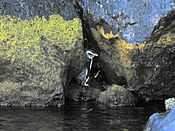 | |
| Yellow-eyed penguin | Megadyptes antipodes | 5930 – 6970[13] | EN[13] | Estimate is dated (1988/89).[13] | 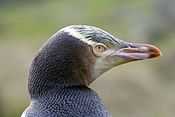 | |
| African penguin | Spheniscus demersus | 75 000 – 80 000[14] | EN[14] | 5000 breeding pairs in Namibia & 21 000 in South Africa.[14] |  | |
| Snares penguin | Eudyptes robustus | 93 000[15] | VU[15] | 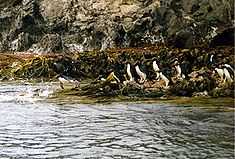 | ||
| Erect-crested penguin | Eudyptes sclateri | 195 000 – 210 000[16] | EN[16] | Population breeds in two locations: the Bounty Islands (26 000 pairs), & the Antipodes Islands (41 000 pairs).[16] | | |
| Northern rockhopper penguin | Eudyptes moseleyi | 530 000[17] | EN[17] | Mature individuals only (265 thousand pairs); population has declined 57% in the past 37 years.[17] |  | |
| Emperor penguin | Aptenodytes forsteri | 595 000[18] | NT[18] | 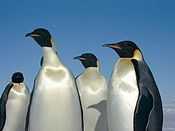 | ||
| Gentoo penguin | Pygoscelis papua | 774 000[19] | NT[19] | Mature individuals only (387 thousand pairs).[19] | 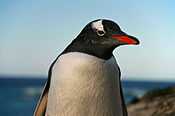 | |
| Royal penguin | Eudyptes schlegeli | 1 700 000[20] | VU[20] | Mature individuals only (850 000 pairs on Macquarie & over 1000 pairs on Bishop and Clerk). Estimate is from the 1980s, but population is stable.[20] | | |
| Southern rockhopper penguin | Eudyptes chrysocome | 2 460 000[21] | VU[21] | Mature individuals only (1.23 million pairs); population has declined 34% in the past 37 years.[21] |  | |
| Magellanic penguin | Spheniscus magellanicus | 2 600 000[22] | NT[22] | Mature individuals only (1.3 million pairs).[22] |  | |
| Adélie penguin | Pygoscelis adeliae | 4 740 000[23] | NT[23] | Mature individuals only (2.37 million pairs).[23] | _21.jpg) | |
| Chinstrap penguin | Pygoscelis antarcticus | 8 000 000[24] | LC[24] | Minimum estimate.[24] |  | |
| Macaroni penguin | Eudyptes chrysolophus | 18 000 000[25] | VU[25] | Mature individuals only (9 million pairs); main population centres at Île des Pingouins, Heard and McDonald (1 million pairs each), Kerguelen (1.8 million pairs), & South Georgia (2.5 million pairs).[25] | 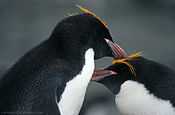 | |
See also
- Lists of birds by population
- Lists of organisms by population
References
- ↑ BirdLife International (2012). "Aptenodytes patagonicus". IUCN Red List of Threatened Species. Version 2012.2. IUCN. Retrieved 2012-12-22.
- ↑ BirdLife International (2012). "Eudyptula minor". IUCN Red List of Threatened Species. Version 2012.2. IUCN. Retrieved 2012-12-22.
- ↑ Dell'Amore, Christine (13 April 2012). "Emperor Penguins Counted From Space—A First". National Geographic News (National Geographic). Retrieved 2012-12-22.
- ↑ Yusuf, Mohammed (29 June 2012). "UNHCR Tries to Count Somalia". Voice of America. Retrieved 2012-11-21.
- ↑ Southwell, C.; Low, M. (2009). "Black and white or shades of grey? Detectability of Adélie penguins during shipboard surveys in the Antarctic pack-ice". Journal of Applied Ecology (46): 136–143.
- ↑ "Annual Galapagos Penguin and Cormorant Census". GNP News (Proceso de Relaciones Públicas – Parque Nacional Galápagos – Ecuador). 2012. Retrieved 2012-12-22.
- ↑ Fox, Rebecca (2008-11-20). "Ancient species of penguin found in DNA of bones". Otago Daily Times. Retrieved 2008-11-20.
- ↑ A.J.D. Tennyson and P.R. Millener (1994). Bird extinctions and fossil bones from Mangere Island, Chatham Islands, Notornis (Supplement) 41, 165–178.
- ↑ Than, Ker (1 Dec 2008). "3/4 of Big Antarctic Penguin Colonies to Disappear?". National Geographic News (National Geographic). Retrieved 2012-12-22.
- ↑ 10.0 10.1 10.2 BirdLife International (2012). "Spheniscus mendiculus". IUCN Red List of Threatened Species. Version 2012.2. IUCN. Retrieved 2012-12-14.
- ↑ 11.0 11.1 11.2 BirdLife International (2012). "Spheniscus humboldti". IUCN Red List of Threatened Species. Version 2012.2. IUCN. Retrieved 2012-12-14.
- ↑ 12.0 12.1 12.2 12.3 BirdLife International (2012). "Eudyptes pachyrhynchus". IUCN Red List of Threatened Species. Version 2012.2. IUCN. Retrieved 2012-12-14.
- ↑ 13.0 13.1 13.2 13.3 BirdLife International (2012). "Megadyptes antipodes". IUCN Red List of Threatened Species. Version 2012.2. IUCN. Retrieved 2012-12-14.
- ↑ 14.0 14.1 14.2 14.3 BirdLife International (2012). "Spheniscus demersus". IUCN Red List of Threatened Species. Version 2012.2. IUCN. Retrieved 2012-12-14.
- ↑ 15.0 15.1 15.2 BirdLife International (2012). "Eudyptes robustus". IUCN Red List of Threatened Species. Version 2012.2. IUCN. Retrieved 2012-12-14.
- ↑ 16.0 16.1 16.2 16.3 BirdLife International (2012). "Eudyptes sclateri". IUCN Red List of Threatened Species. Version 2012.2. IUCN. Retrieved 2012-12-14.
- ↑ 17.0 17.1 17.2 17.3 BirdLife International (2012). "Eudyptes moseleyi". IUCN Red List of Threatened Species. Version 2012.2. IUCN. Retrieved 2012-12-14.
- ↑ 18.0 18.1 18.2 BirdLife International (2012). "Aptenodytes forsteri". IUCN Red List of Threatened Species. Version 2012.2. IUCN. Retrieved 2012-12-14.
- ↑ 19.0 19.1 19.2 19.3 BirdLife International (2012). "Pygoscelis papua". IUCN Red List of Threatened Species. Version 2012.2. IUCN. Retrieved 2012-12-14.
- ↑ 20.0 20.1 20.2 20.3 BirdLife International (2012). "Eudyptes schlegeli". IUCN Red List of Threatened Species. Version 2012.2. IUCN. Retrieved 2012-12-14.
- ↑ 21.0 21.1 21.2 21.3 BirdLife International (2012). "Eudyptes chrysocome". IUCN Red List of Threatened Species. Version 2012.2. IUCN. Retrieved 2012-12-14.
- ↑ 22.0 22.1 22.2 22.3 BirdLife International (2012). "Spheniscus magellanicus". IUCN Red List of Threatened Species. Version 2012.2. IUCN. Retrieved 2012-12-14.
- ↑ 23.0 23.1 23.2 23.3 BirdLife International (2012). "Pygoscelis adeliae". IUCN Red List of Threatened Species. Version 2012.2. IUCN. Retrieved 2012-12-14.
- ↑ 24.0 24.1 24.2 24.3 BirdLife International (2012). "Pygoscelis antarcticus". IUCN Red List of Threatened Species. Version 2012.2. IUCN. Retrieved 2012-12-14.
- ↑ 25.0 25.1 25.2 25.3 BirdLife International (2012). "Eudyptes chrysolophus". IUCN Red List of Threatened Species. Version 2012.2. IUCN. Retrieved 2012-12-14.

